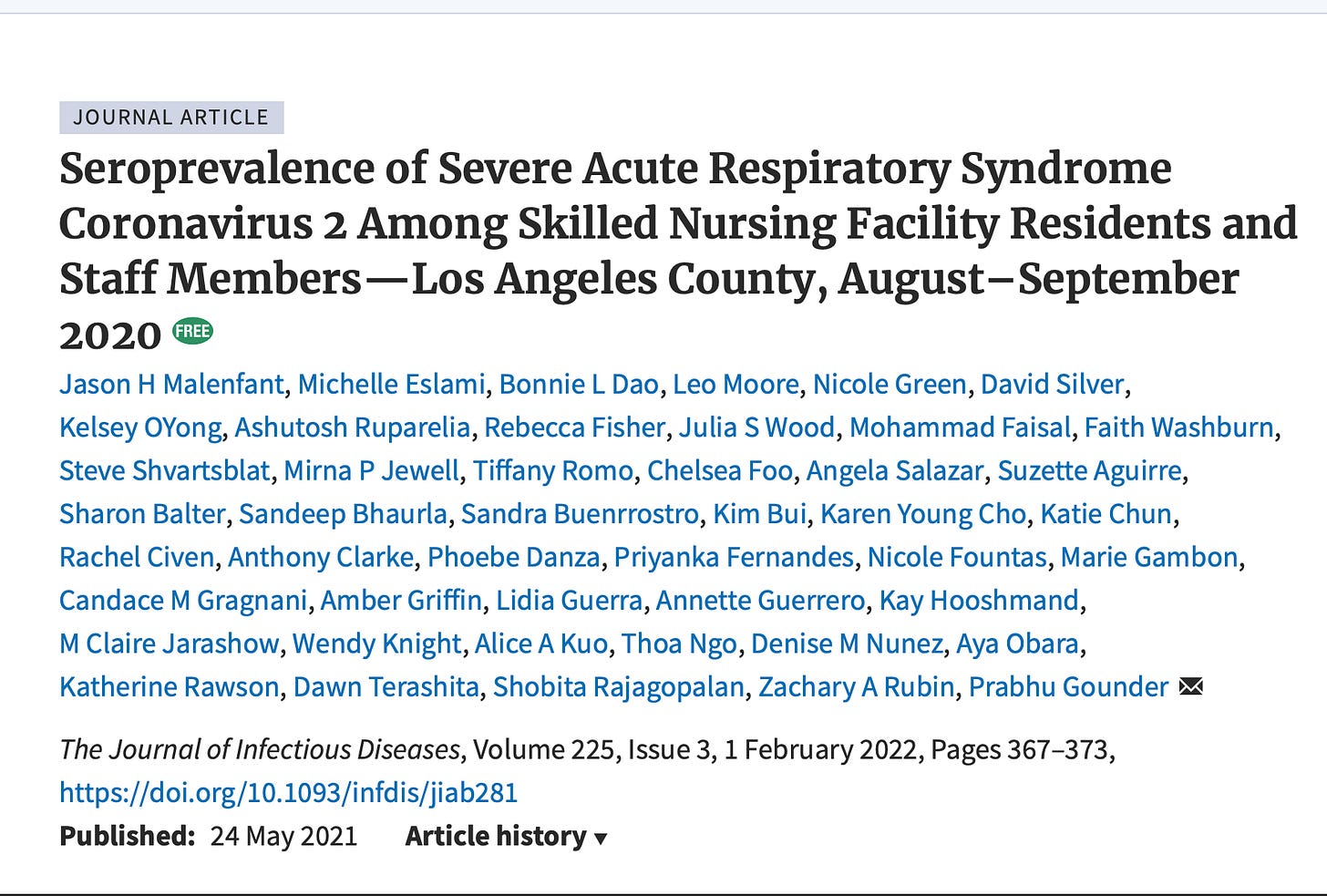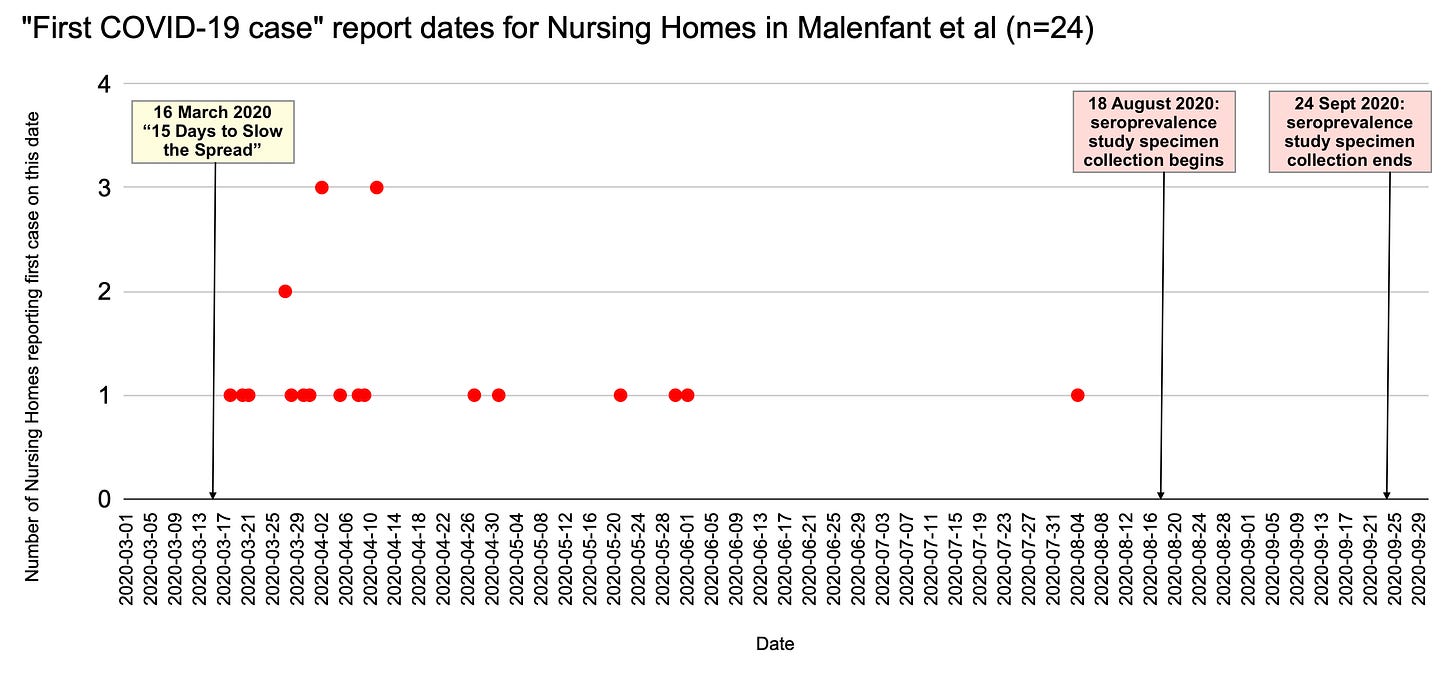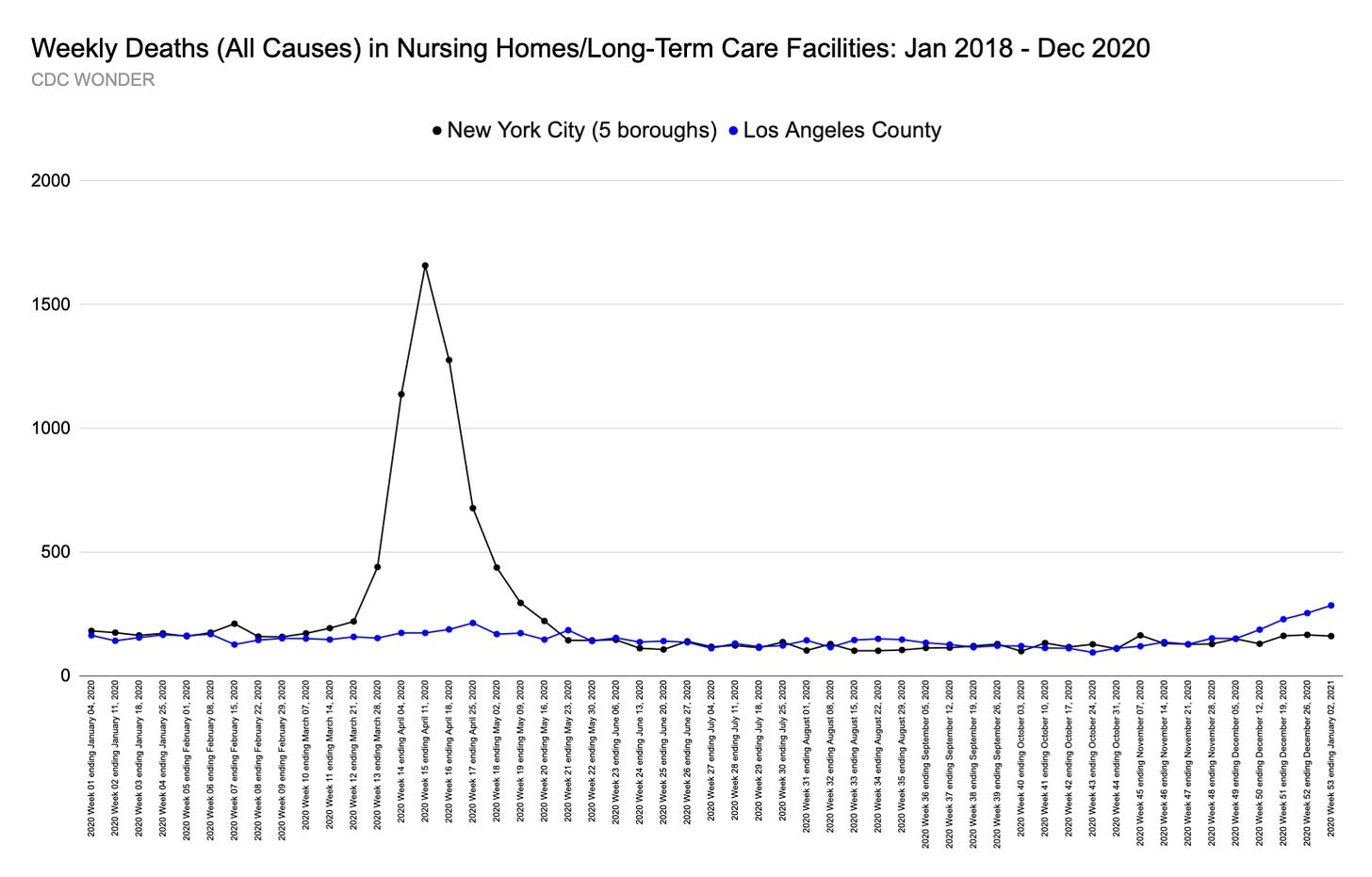If It's So Deadly, Then Why Wasn't it Deadly?
A Los Angeles County nursing home serology study raises fundamental questions about SARS-CoV-2
Two years ago, an acquaintance I’ll call Beth brought an interesting study to my attention. Its results should make any reasonable person who hasn’t already reconsidered the nature of SARS-CoV-2—and the testing associated with it—do so.
Overview of the Study
Published in 2021, Seroprevalence of Severe Acute Respiratory Syndrome Coronavirus 2 Among Skilled Nursing Facility Residents and Staff Members - Los Angeles County, August - September 2020 (Malenfant et al) collected specimen from residents and staff in 24 private nursing homes owned by a single company. The study aimed to assess the number of SARS-CoV-2 infections that were previously “undetected” due to “asymptomatic infections” and “limited testing capacity” during the initial months of the pandemic declaration.1 A total of 3,305 participants—1,340 residents and 1,965 staff members—provided varying types of samples, including nasopharyngeal swabs for PCR testing, serum or plasma for serological testing, or both, between 18 August 2020 and 24 September 2020.2
The Department of Public Health (DPH) surveillance database was used to identify residents and staff who had previously tested positive for SARS-CoV-2. Serology results were analyzed to detect SARS-CoV-2 antibodies (IgG and/or IgM).
Results
Of 856 residents who provided serum, 346 (40%) had detectable SARS-CoV-2 antibodies; 199 (58%) of these residents did not have a documented prior positive SARS-CoV-2 PCR result.
Of 1806 staff members who provided serum, 447 (25%) had detectable SARS-CoV-2 antibodies; 353 (79%) did not have a documented prior positive SARS-CoV-2 PCR result.
Reacting to these results via email, Beth asked,
“If this disease is so deadly, why would 58% of the residents have tested positive for serology, but never tested positive on a PCR? How could it be so mild/asymptomatic in those age groups most vulnerable?”
Those are good questions.
What should we make of the relatively high percentage of nursing home residents for whom SARS-CoV-2 was not significant enough to produce a positive result on an overly sensitive, non-specific PCR test—despite being described as a virus that poses the greatest risk to the elderly and those with comorbidities?
All of the nursing homes had reported a COVID-19 outbreak before the study period. Isn’t it curious that this new virus triggered antibody production but neither a PCR-positive result nor, presumably, significant symptoms in nearly 60% of those who tested seropositive?
The 2,650 resident and staff participants with documented SARS-CoV-2 PCR test results had been tested 2–6 times. This suggests testing rate and availability were more than sufficient. ‘Persistent positivity’ on PCR tests is a documented phenomenon - and (apparently) an even bigger problem in the elderly (e.g., Howard-Jones et al, 2021), making the seroprevalence results even more remarkable.
Most (though not all) of the nursing homes recorded their first cases in March and April 2020, after the U.S. declared an emergency and began deploying tests. Presumably, these cases (i.e., positive tests) marked the ‘beginning’ of each facility’s reported outbreak, during which outbreak testing was conducted.3
Graph created from information provided in the Supplemental Materials in Malenfant et al, 2020)
Additionally, staff in these facilities had also been infected at high rates, according to the results—meaning residents were being cared for by individial carrying the allegedly high-risk and purportedly transmissible pathogen. In short, there’s no good “excuse” for the high percentage of sero-positive/no record of PCR-positive individuals.
Is it possible the serology tests were overly sensitive, non-specific, and are, in any event, generally meaningless with respect to coronaviruses? Yes. (The same could be said—and has been said—about SARS-CoV-2 PCR tests and PCR testing as a diagnostic tool.)
Differentially Deadly?
Malenfant, et al don’t report the number of deaths (“COVID” or otherwise) in the facilities. However, federal data show no increase prior to the “15 Days to Slow the Spread” decree, which was followed by only a very modest rise and then a decline.4 The increase in December came as the COVID shot was being deployed.
Like L.A., most of New York City’s excess death in 2020 occurred in hospitals rather than in nursing homes but a comparison (below) is illustrative of the bi-coastal absurdities we’re expected to accept.
Some have proposed that different variants made their way from Wuhan to Iran, Italy, and New York City on one coast—and from Wuhan to cruise ships, military vessels, and Seattle/Los Angeles on the other. That defies common sense and sounds more like science fiction than science.5
Beth’s question remains: If “it” is so deadly, then why wasn’t it deadly?
The answer provided by this L.A. nursing home study is “because *it* wasn’t at all what we were told.”
Related:
Note: I am repeating, not validating, the researchers’ assumptions. There is never a need to test people who don’t have symptoms, or to test anyone for anything unless it directs or changes the course of treatment. Whether testing of any kind is needed for treated most manifestations of respiratory illness is debatable. | “Testing shortage” is an oft-repeated canard about spring 2020.
Breakdown: “Among the 1340 resident participants, 704 (53%) provided both NP swab and serum specimen, 484 (36%) provided nasopharyngeal swab specimen alone, and 152 (11%) provided serum specimen alone. Among the 1965 staff member participants, 1674 (85%) provided both NP swab and serum specimens, 159 (8%) provided NP swab specimen alone, and 132 (7%) provided serum specimen alone.”
Change made post-publication to connect the first cases, outbreaks, and testing. Section previously said, Recall as well that each of the 24 nursing homes in the study had reported COVID-19 outbreaks. Most (though not all) recorded their first cases in March and April 2020, after the U.S. declared an emergency and began deploying tests.
The same is generally true of spring 2020 deaths in Los Angeles County hospital inpatient, as shown here. So, even if nursing home patients were transferred to hospitals in the spring and died there, it didn’t drive excess deaths in hospitals to high levels.
Sequencing identifies multiple early introductions of SARS-CoV-2 to the New York City region is one study which bolstered that notion.
wrote a bit about it here.






There are a lot of Asimov's "Hmm that's funny... 's in those stats. There is really no way to have all of those things be true and for the narrative to survive. What we can say is more than likely true: 1-Serology tests are AT BEST highly unreliable, which completely disqualifies them for drawing any significant conclusions. 2- PCR testing is AT BEST highly unreliable and when it doesn't correlate with unique clinical observations of illness is complete misleading trash (asymptomatic silent spread!!). 3- Whatever "it" may have been, it was neither deadly nor highly contagious in at least MOST situations, not even for the elderly (see also the Diamond Princess). 4- All those things being true, the "pandemic", wasn't. 5- there is no way to justify the measures taken, certainly not in hindsight, but also certainly 5 years ago because all those things were known 5 years ago.
I wonder how many of us have considered what it is, exactly, that is being measured in “covid serology”?
There a number of ways to approach the question, “Are there antibodies to something relevant to an illness in this patient’s blood sample?”
It’s not necessary to believe in germ theory for this question to be reasonable. Some people have antibodies to chemical adducts formed as a result of ingesting a drug which can give rise to reactive products which can bind to long-lived structural proteins. This is a new molecule which your body may recognise as foreign, prompting autoimmune attack. Antibodies might be a part of that.
If you wanted to investigate whether the individual was carrying such antibodies, you might synthesise in a lab some of the adduct and adhere it to the bottom of plastic, multi-welled plates. You could then add a sample of the patient’s serum, then wash the plate, then “develop” it by adding, for example, donkey-anti human antibodies to which a colour-generating molecule has been bound. When you’ve done the last step, allowing colour to appear, the amount of the colour is precisely measured using a spectrophotometer.
The important thing to note is that any such measurement is indirect. You can’t directly measure the amount of “antibody to the alleged virus”.
I don’t know what procedure is followed when doing the serology referred to here. I remember looking, a couple of years ago, for the original “methods paper” and not finding it. By this I mean an analogous paper to the one for the original PCR based test for the alleged virus (aka the Corman-Drosten paper). Given how widely serology has been used, it’s critical to understand exactly how what’s claimed to be able to measure “circulating antibodies to SARS-CoV-2” works. Pitfalls in the broad category of what are called “immunoassays” are legion. It’s very common to uncover cross-reactivity to things other than the nominal objective.
Without the methods paper, I tend to disregard any claims made about serology in this context. Unlike PCR, development and use of immunoassays is something I’ve done personally (they were considered quite new technology back then!). One thing is certain. These assays cannot be measuring antibodies to “SARS-CoV-2 virus”, because that’s an in silico construct. It isn’t antibodies to “related coronaviruses” for the same reason.